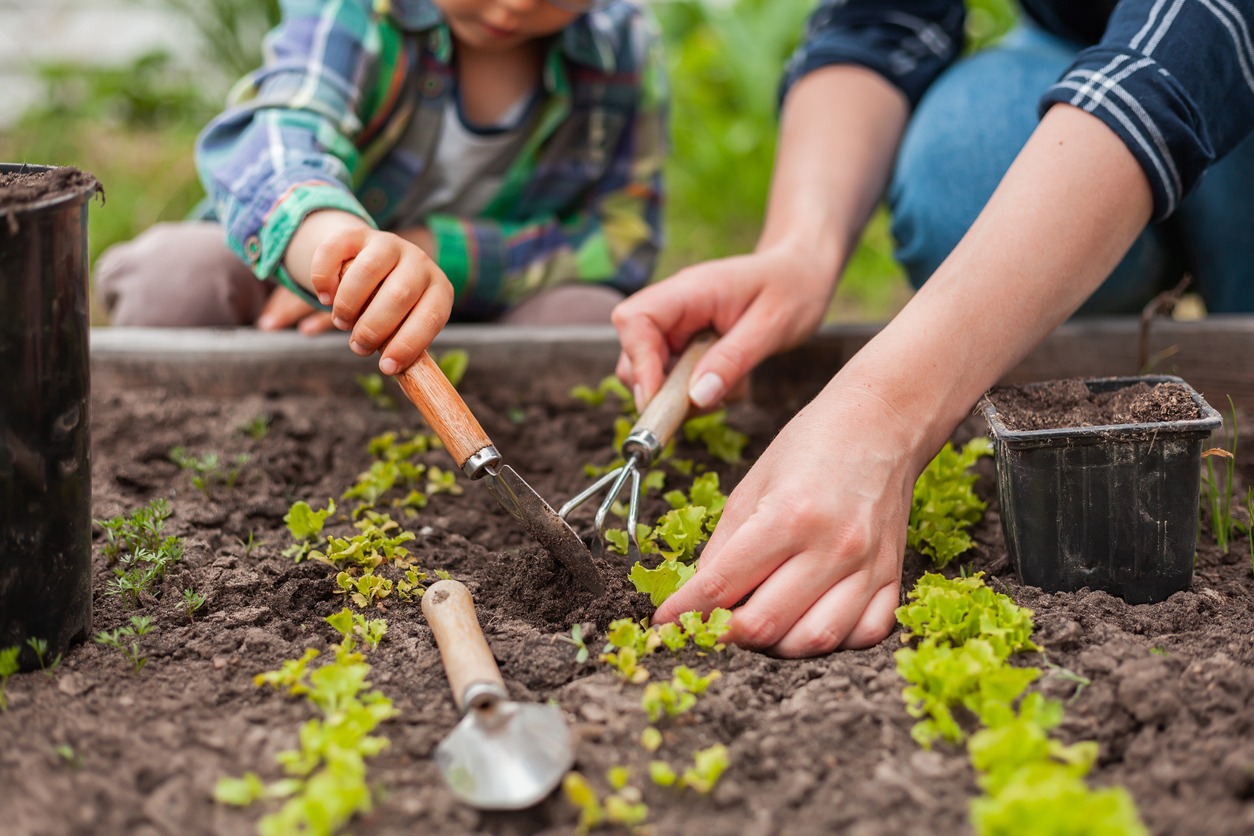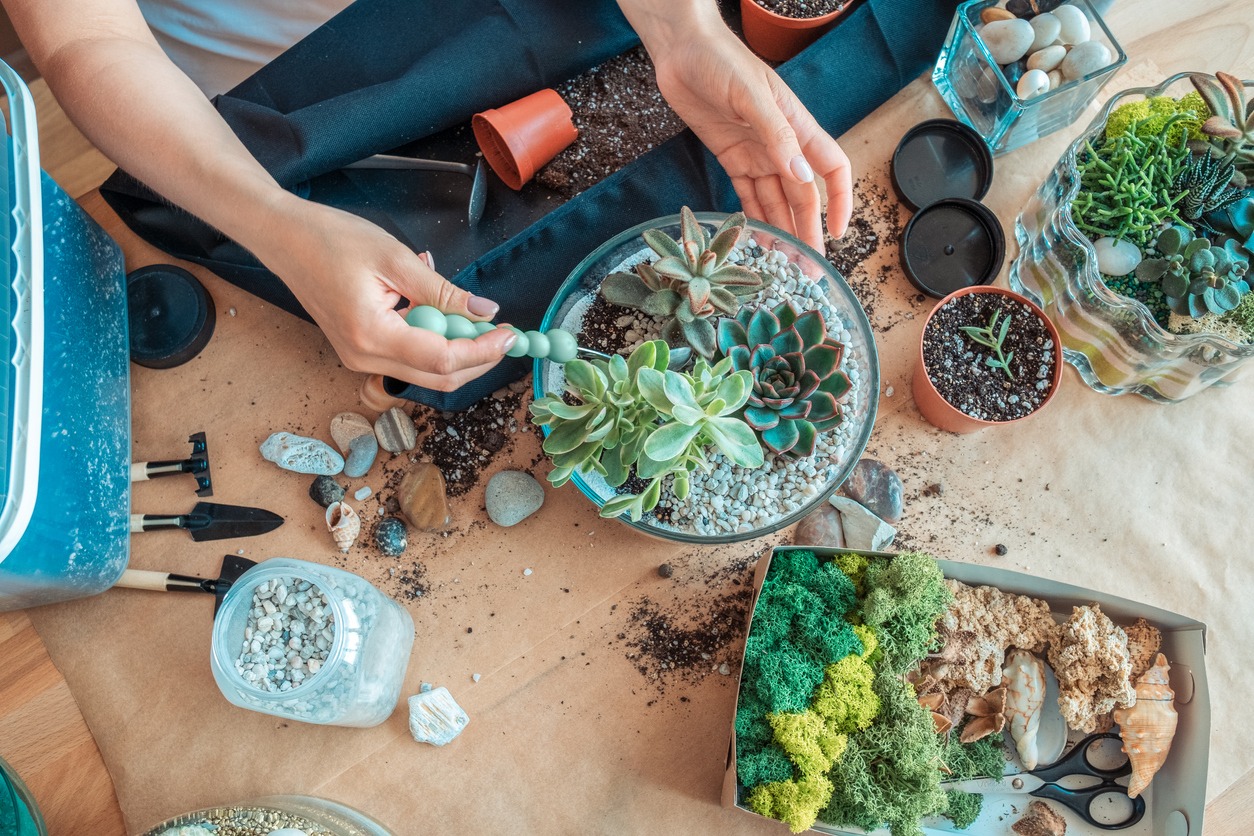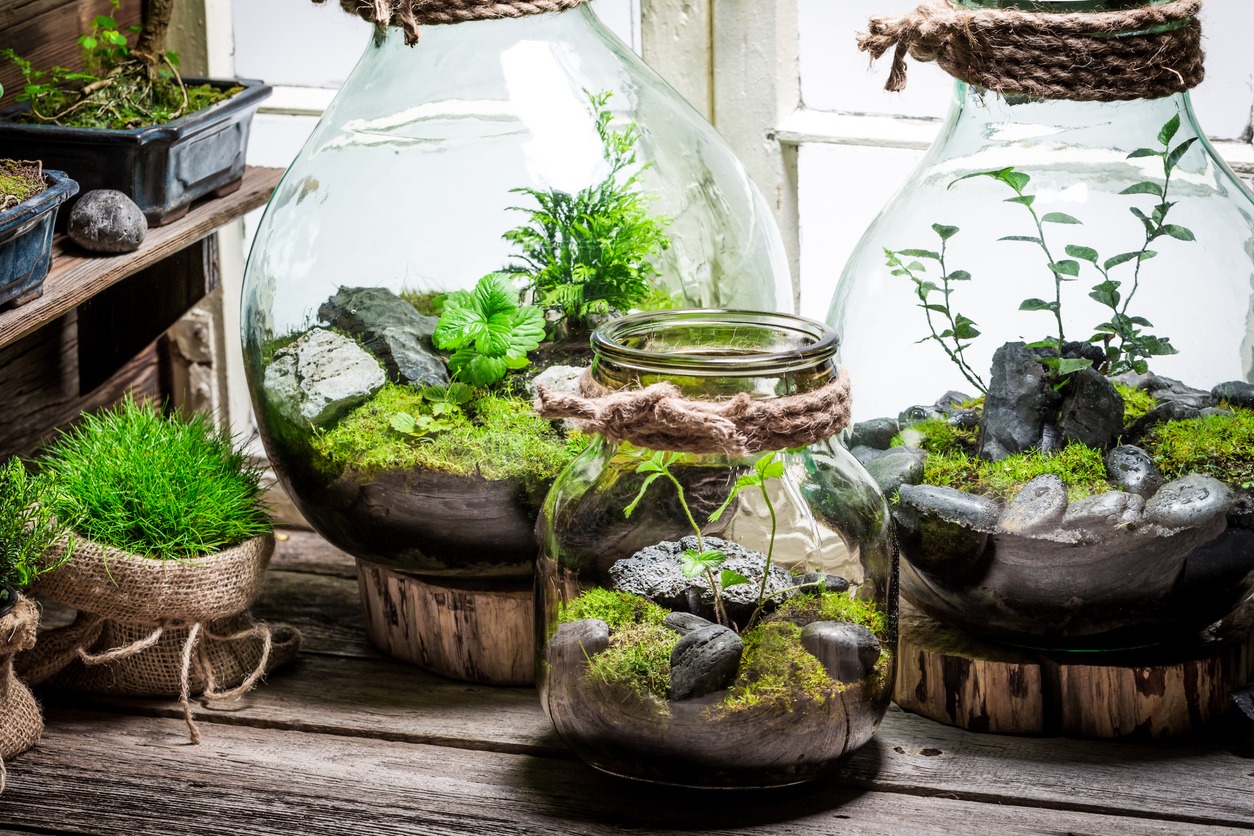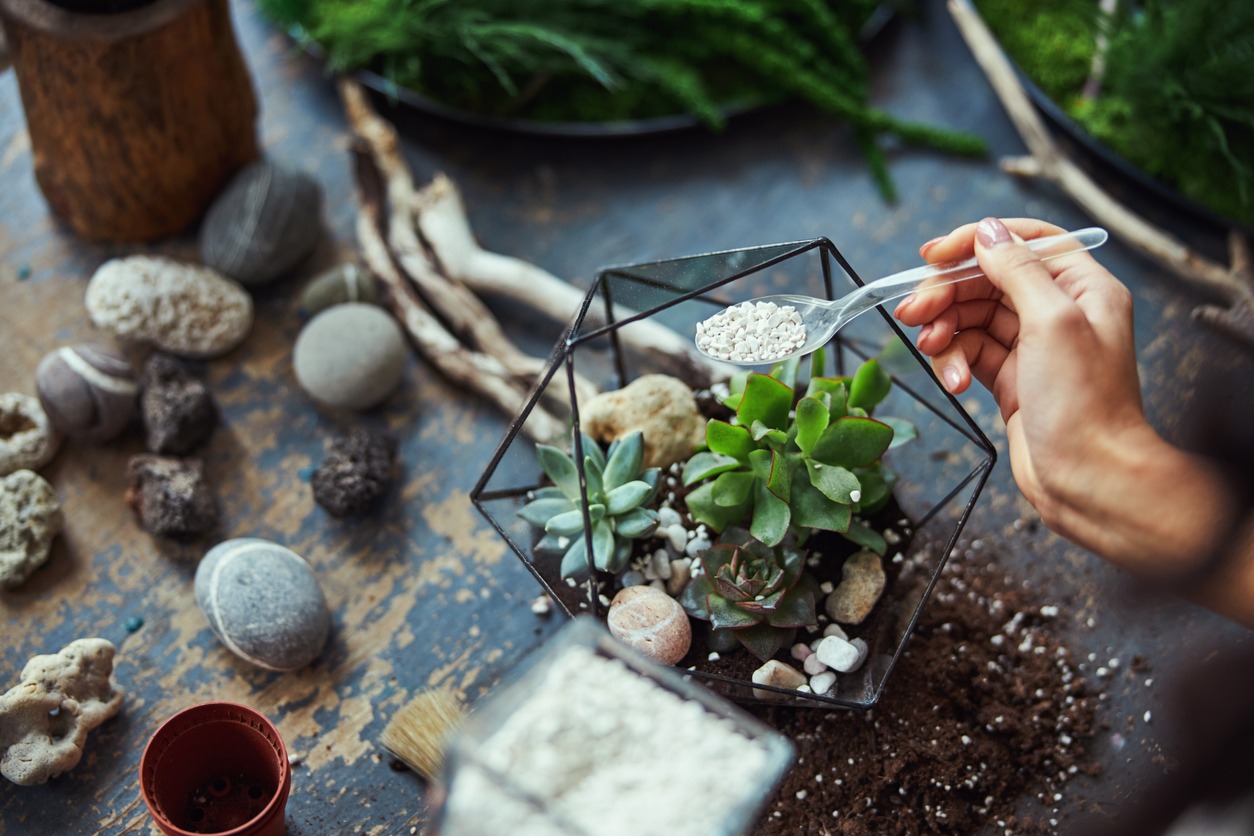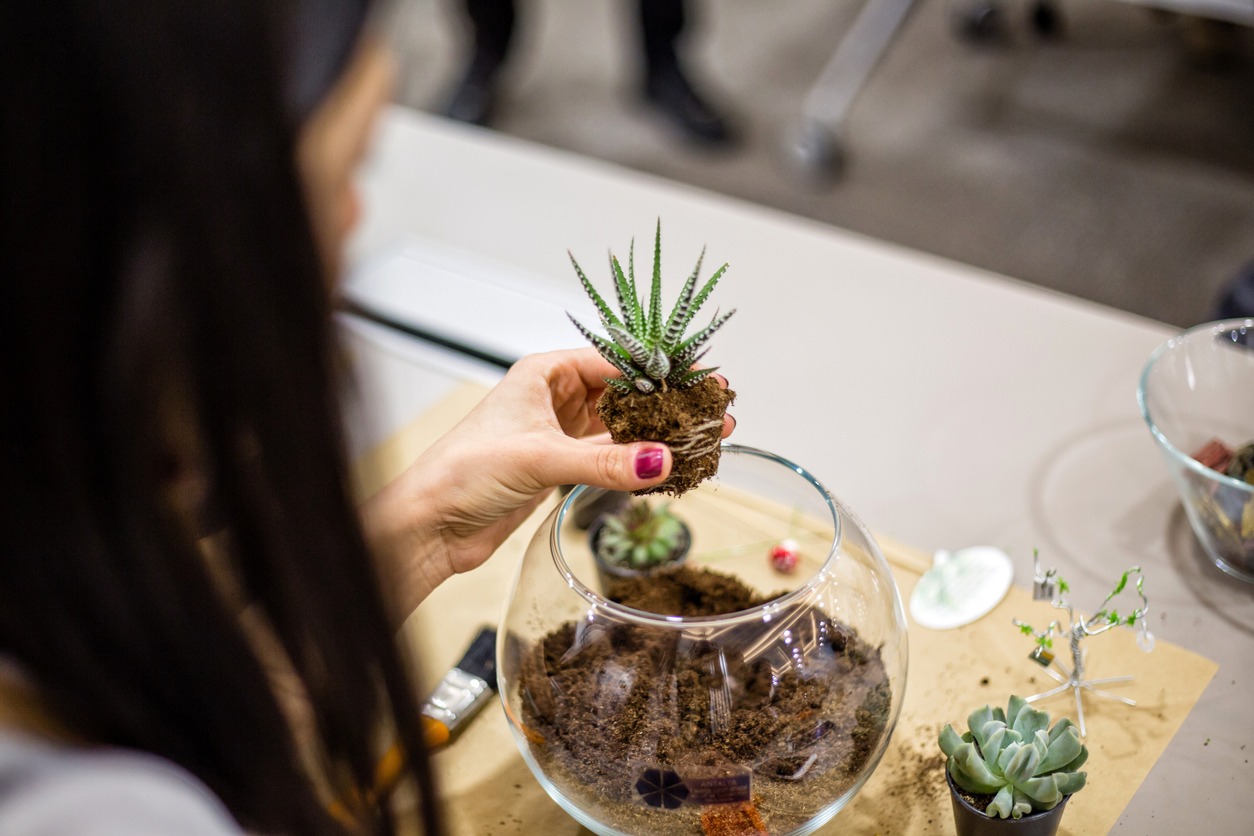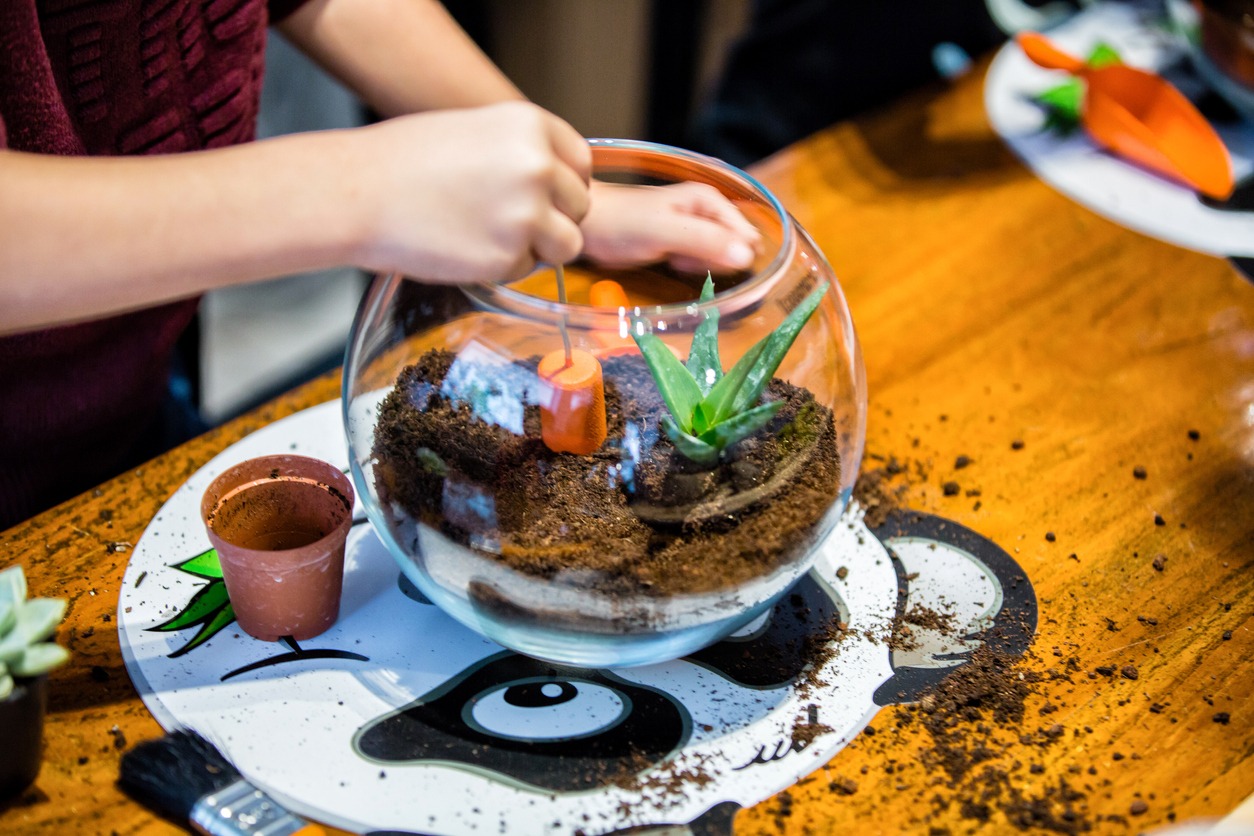The creative and artistic horticultural practice of miniature gardening entails designing and cultivating small-scale landscapes in containers or outdoor garden beds. Miniature gardens can be grown indoors or outdoors. These miniature gardens typically consist of minuscule plants, decorative elements, and scaled-down accessories, all of which work together to produce an alluring and enticing representation of a natural setting. The goal of miniature gardening is to evoke a sense of wonder and enchantment in a small space. Because of this, many enthusiasts find that miniature gardening is a delightful and imaginative hobby.
Brief History of Miniature Garden
The creation of small gardens in pots and containers for a variety of purposes can be traced back to ancient civilizations, which is where the practice of miniature gardening can be said to have originated. However, over the last century, the idea of miniature gardening as a specialized hobby has developed into its modern form. It was during the Victorian era in Europe when miniature gardens were frequently crafted to replicate larger landscapes in a compact form. During this time, the practice gained a significant amount of popularity. These kinds of gardens have also been called “fairy gardens” and “tabletop gardens.”
The art of bonsai, which is practiced in Japan and involves the cultivation and shaping of small trees and plants, is comparable to the practice of miniature gardening in some respects. The art of bonsai has been around for centuries and has had a significant impact on the culture of miniature gardening in several different ways.
Over the past few decades, people all over the world have shown renewed interest in the hobby of miniature gardening. Gardeners and people who enjoy crafting enjoy the challenge of creating intricate and whimsical landscapes on a small scale, and this pastime has become very popular among people who enjoy those activities.
Popularity and Trends In Miniature Garden
The recent years have seen a surge in the popularity of miniature gardening, which has been driven by several different trends and factors. The following is a list of some of the most important aspects that contribute to its popularity and the current trends:
Creativity and Personalization
One of the primary factors that contribute to the growing popularity of miniature gardening is the fact that it allows for a great deal of room for creative expression and individualization. To create one-of-a-kind and captivating settings, enthusiasts have a wide selection of miniature plants, figurines, and accessories from which to choose. Individuals can exhibit their unique personalities and levels of imagination through the designs of their miniature gardens thanks to this aspect of creativity.
Therapeutic Benefits
One activity that is frequently considered to be therapeutic and relieving of stress is miniature gardening. The act of designing and maintaining one of these miniature landscapes can provide the creator with a meditative and relaxing experience. It offers a sense of tranquility and mindfulness, providing an escape from the hustle and bustle of day-to-day life and providing an opportunity to reflect.
Indoor and Outdoor Options
Another aspect that contributes to the growing popularity of miniature gardening is the versatility of the practice. Indoor and outdoor spaces are both suitable for the cultivation of miniature gardens. Because of its adaptability, it is suitable for people who have restricted access to outdoor space, such as those who live in apartments, as well as those who live in areas with severe weather conditions.
Social and Community Aspect
A sense of community and shared interests have been fostered through the development of offline and online communities of people who are passionate about miniature gardens. People who are passionate about something frequently get together to trade insights, recommendations, and ideas. This sense of community and collaboration in the creative process contributes to the allure of the hobby and helps to foster its expansion.
Sustainability and Eco-Friendly Practices
The concept of sustainable and environmentally friendly gardening practices frequently aligns with miniature gardening. There are a lot of people who are passionate about recycling and using natural materials in their creations. This emphasis on environmental responsibility strikes a chord with people who are anxious about the negative effects their hobbies may have on the surrounding environment.
Integration with Technology
The advent of the digital age has been an important contributor to the rise in popularity of miniature gardening. Through various social media platforms, websites, and online forums, enthusiasts discuss the designs of their miniature gardens and the sources of their inspiration. This online presence makes it possible for enthusiasts to communicate with like-minded individuals all over the world, share their work, and keep abreast of emerging fashions and methods.
Specialized Products and Accessories
The market for miniature gardening products and accessories has grown, resulting in a greater selection of items that fall into various specialized categories. This includes things like miniature furniture and lighting, as well as themed decorations and pathways. Enthusiasts can choose from a vast array of products that are specifically crafted to cater to their individual design preferences.
Themed Miniature Gardens
The popularity of themed miniature gardens has increased, with enthusiasts creating miniature versions of scenes from fairy tales, Japanese gardens, desert landscapes, and other types of environments. Within the realm of the hobby of miniature gardening, these themed gardens open up opportunities for creative storytelling and expression.
In a nutshell, the ability of miniature gardening to provide an outlet for creative expression, therapeutic benefits, and a strong sense of community are likely contributing factors to the recent uptick in the hobby’s popularity. Its adaptability to a variety of settings, emphasis on sustainability, and integration with technology have also contributed to the widespread appeal that it has garnered. The landscape of the hobby has been further enriched by the accessibility of specialized products as well as the development of themed gardens.
Types of Miniature Gardens
The term “miniature gardening” refers to a wide variety of garden styles, each of which has its own set of distinguishing characteristics and fundamentals of layout. The following is a list of some of the most common kinds of miniature gardens:
Fairy Gardens
Enchanting and whimsical miniature landscapes known as “fairy gardens” typically include diminutive figurines of fairies, gnomes, and other enchanted creatures. Fairy gardens are also known as “enchanted gardens.” These gardens are intended to evoke a sense of awe and fantasy in their visitors. Small plants, such as mosses, miniature ferns, and flowers of a miniature size are typically included in fairy gardens. The magical atmosphere is brought to life through the incorporation of various ornamental components, such as miniature bridges, cottages, and furniture.
Terrarium Gardens
Terrarium gardens are miniature ecosystems that can be kept alive and flourish inside either closed or open-topped glass jars. They are well-known for requiring little attention, which makes them an excellent option for gardening indoors. Plants such as succulents, air plants, or even miniature tropical plants can be housed inside of terrariums. Terrariums are also known as “terrarium gardens.” While open terrariums need to be watered on occasion, closed terrariums produce an environment that can maintain itself and ensure that moisture is continually recirculated. These miniature gardens are not only beautiful but also educational because they allow you to see the natural life cycle of plants up close and personal.
Dish Gardens
Dish gardens also referred to as container gardens, are planted in shallow containers or trays and are designed to look like dishes. They have a wide range of applications and can be constructed either indoors or outdoors. Dish gardens can contain a wide variety of miniature plants, including cacti, succulents, or even small herbs. Dish gardens are also known as terrariums. To further enhance the aesthetic value, decorative components like stones, pebbles, and miniature figurines might be added here and there. Dish gardens are frequently utilized in homes and outdoor areas both as focal points of the room as well as decorative accents.
Bonsai Gardens
The art of bonsai gardening involves the cultivation and shaping of miniature versions of shrubs and trees. The art of bonsai, which originates in Japan, focuses on the creation of miniature, sculpted trees that are meant to resemble their full-sized counterparts. To achieve the desired form and size, it is necessary to perform careful pruning, training, and maintenance. Bonsai gardens are well-known for their aesthetic beauty and balance, in addition to the symbolic meanings that are connected to the various types of trees that are used in this art form.
Succulent Mini Gardens
As a result of the low amount of care that is required for succulent plants, miniature succulent gardens are experiencing a surge in popularity. The majority of the plants found in these gardens are succulents, which can range greatly in appearance in terms of their form, size, and color. Succulents thrive in confined spaces and can go for extended periods without being watered when properly cared for. Because of their varied appearances, succulents are frequently used in miniature gardens because they lend themselves well to the creation of designs that are both original and aesthetically pleasing.
These are just some of the many varieties of miniature gardens that can be crafted by an individual. Each variety provides its one-of-a-kind chances for creativity and individualization, making it suitable for a wide range of preferences and skill levels in the gardening realm. There is a miniature gardening style that will appeal to everyone, whether it’s the whimsicality of a fairy garden, the serenity of a bonsai garden, or the contemporary charm of succulent mini gardens.
Essential Components of a Miniature Garden
The creation of a successful miniature garden requires the incorporation of several crucial components. The following is a rundown of the materials that you will require to create your very own miniature garden:
Plants
Plants are an essential element in the creation of miniature gardens because they supply the verdant elements and the life that bring these gardens to life. Choose plants that are either naturally dwarfed or can have their size reduced through appropriate pruning and care. The following types of plants could be considered suitable:
Mosses: The use of mosses as ground cover results in an appearance that is similar to that of a thick carpet.
Miniature Ferns: Your garden will look more refined as a result of the addition of these delicate plants.
Succulents: The hardiness and diversity of miniature succulents have contributed to their widespread popularity.
Small Herbs: It is possible to incorporate fragrant herbs such as thyme or miniature basil that can also be used in cooking.
Bonsai Trees: A traditional option is a bonsai tree that is a true bonsai and has been trained to stay small through careful pruning and shaping.
Air Plants: These epiphytic plants can be grown in your garden by attaching themselves to various ornamental features.
Planting Techniques are:
Plant Placement: Take into consideration the tendencies of growth and the lighting needs of the plants you have chosen. Arrange them in such a way that they have sufficient space and access to light wherever you put them.
Proper Planting Depth: Make sure that the plants are planted at the appropriate depth in the soil or container when you are planting them. This will give the plants time to grow roots.
Regular Pruning: You must prune and tend to your plants consistently to preserve the miniature scale. They can be trimmed and shaped as required.
Containers
You have your choice between several containers, including:
Terrariums: containers made of glass, either open or sealed, that are perfect for growing succulents and air plants.
Bonsai Pots: geared exclusively toward the cultivation of bonsai trees.
Dish or Tray Containers: containers with a shallow depth that are suitable for a variety of arrangements.
Hypertufa Troughs: Stone-like containers that have been handcrafted and add a touch of country charm.
Teacups, Teapots, or unusual vessels: Containers that are imaginative and whimsical, for use in one-of-a-kind designs.
Choosing the right container:
Choose a container whose design and aesthetic will work well with the concept of your miniature garden. Take into account the size and depth of the container, as this will affect the plants that you choose as well as the overall design.
Soil and Fertilizers
The health of the plants and their growth in miniature gardens must have the appropriate soil and nutrition.
Soil types:
Potting Mix: Make sure to use a potting mix that has good drainage and is designed for the kinds of plants you’ve decided to grow. Numerous miniature gardens would benefit from the addition of a cactus or succulent mix.
Sphagnum moss: In terrariums, top dressings made of this substance are frequently used to help keep the soil moist.
Fertilizers and Nutrition
Diluted Fertilizers: During the growing season, use liquid fertilizers that have been diluted and balanced sparingly, typically at half their normal strength.
Slow-Release Fertilizers: When you plant seeds, work fertilizers with a slow release or granules that are rich in nutrients into the soil.
Accessories and Decorations
Your miniature garden will have more character and allure with the addition of accessories and decorations. You can make your accessories by working with materials such as:
Miniature furniture: Make miniature versions of chairs, benches, and tables.
Pathways: Use pebbles and other small stones to create winding pathways.
Tiny signs, fences, and gates: Construct them using wood or any other suitable material.
Pebble and rock features: Make little ponds or rocky landscapes out of the rocks.
Handmade figurines: Create your very own gnomes, fairies, or animals out of clay or any other material you like.
You can also find a wide selection of pre-made accessories and decorations, such as miniature versions of garden gnomes, bridges, birdhouses, and many other types of structures. These items have the potential to lend both practicality and personality to your miniature garden.
You can design a one-of-a-kind and beguiling miniature garden that is suited to your sense of taste and sense of style by giving careful consideration to the selection and arrangement of these components. The hobby of miniature gardening is not only enjoyable and creative, but it also provides limitless opportunities for individuals to express themselves creatively and aesthetically.
Designing a Miniature Garden
The process of designing a miniature garden can be both creative and enjoyable, and it requires careful consideration of several different elements. The following are the primary actions involved in the design of a miniature garden:
Theme Selection
Determine an overall concept for your miniature garden before you get started. Your design decisions will be more cohesive and visually appealing if you choose a theme that resonates throughout the garden. The following are some examples of popular themes:
Fairy Garden: Using fairy figurines, miniature houses, and other whimsical decorations, you can build a world that is enchanted.
Desert Landscape: To create the effect of a miniature desert scene, use succulents and cacti.
Woodland Retreat: For an environment that feels more like a forest, add elements such as mosses, ferns, and animals that live in the woods.
Japanese Zen Garden: A peaceful Zen garden can be created by arranging rocks, sand, and bonsai trees that have been meticulously pruned.
Beach Paradise: Your miniature garden can feel more like the beach with the addition of miniature beach chairs, seashells, and sand.
Do some research and collect ideas related to the topic you’ve chosen. Do some research by looking at other miniature gardens, as well as books, magazines, and online resources. Pinterest and other social media platforms are often very helpful places to look for ideas.
Layout Planning
Container Selection: Pick a container that is suitable for the plants you’ve chosen, one that also fits in with the aesthetic of the space. Take into account the dimensions and shape of the container, as this will determine the possibilities for the layout.
Layout Design: Create a layout for your miniature garden that fits within the confines of the container. Think about how you want the plants, pathways, and decorative elements to be arranged. Arrange the components in a way that is both aesthetically pleasing and contributes to the overall theme that has been selected. If you want your design to be harmonious, you need to pay attention to balance and symmetry.
Hardscaping: It is essential to include hardscaping elements in your garden, such as pathways, rocks, and fences, to give your garden structure and interest. These components help define spaces within the garden and can direct one’s gaze in a particular direction. Create pathways and demarcate areas with the help of small stones, pebbles, or other paving materials in miniature form.
Scale and Proportion
To create a realistic and captivating miniature garden, it is essential to keep the appropriate scale and proportion throughout the entire project.
Scale: Make sure that all of the components of your garden, including the container, are in appropriate proportion to one another. Take into consideration the scale of the accessories, plants, and figurines you intend to use. Try not to overcrowd the area or use items that are too big for the available space.
Proportion: Take into consideration the relative sizes of the various components that make up the garden. For instance, if you have a small container, you should use plants and accessories of a similar scale so as not to make the space appear cluttered. A harmonious and aesthetically pleasing design must have proper proportioning to be successful.
Adding Details and Personal Touch
Decorative Accessories: The addition of decorative accessories will do wonders for the allure of your miniature garden. These can take the form of miniature furniture, animals, garden gnomes, signs, and any other decorative items that are in keeping with the overall concept of your display.
Personalization: Include things or components in your garden that are meaningful to you in some way, so that it has more of a personalized feel. This could be a teeny-tiny trinket, a teeny-tiny replica of your favorite place, or anything else that lends a personal touch to the garden.
Maintenance: Maintaining your miniature garden requires regular tasks such as cutting back plants, cleaning the container, and inspecting the various components to determine whether or not they require any repairs or replacements. You may need to make adjustments to the layout as the plants grow to maintain the desired scale and proportion.
The process of making a miniature garden can be very enjoyable and imaginative, and it allows you to express your creative side and design abilities. By adhering to these steps and giving careful consideration to the theme, layout, scale, and personalization of your miniature garden, you will be able to create an enchanting addition to your space that will fill it with joy and wonder.
Maintenance and Care of Miniature Gardens
It is essential to provide your miniature garden with the appropriate maintenance and care to keep it healthy, vibrant, and looking its best. The following is a list of important things to keep in mind when tending to your miniature garden:
Watering Techniques
Assess Plant Needs: Various plants in your miniature garden may have different requirements for how much water they need. You should investigate the particular requirements that the plants you’ve chosen have and then water them appropriately. The majority of miniature gardens, particularly those that contain succulents, slightly drier favor conditions.
Test Soil Moisture: You can determine how much moisture is in the soil by using your finger. You should only water when the top inch or so of the soil is dry to the touch. Root rot can be caused by overwatering a plant.
Use a Spray Bottle: Consider using a spray bottle to mist the plants with a fine spray of water when caring for plants that are contained in small containers such as terrariums. This can help maintain appropriate moisture levels without causing the plant to receive an excessive amount of water.
Proper Drainage: Make sure that your container has adequate drainage so that water does not collect at the bottom of the container. Root rot can be prevented, at least in part, by using containers with drainage holes and soil that drains well.
Pruning and Trimming
Regular Maintenance: It is necessary to perform regular pruning and trimming on miniature gardens to preserve their scale and shape. The garden’s equilibrium can be thrown off if some plants have grown too large for their space.
Use Precision Tools: Invest in gardening implements that are small and precise, such as miniature pruners or bonsai shears. The use of these tools makes it simpler to prune plants and keep their growth under control.
Prune with Care: When you are pruning, take your time and make cuts that are incremental and small. Take a few steps back every so often to evaluate the overall appearance of the plant and make sure you’re on track to achieve the desired form.
Pest Control
Inspect Regularly: Be on the lookout for unwanted visitors such as aphids, mealybugs, or spider mites. Regular inspections of your plants and decorative items will help you spot any pest problems early on.
Natural Remedies: To get rid of common garden pests, you might want to try using natural remedies such as neem oil or soap that kills insects. These alternatives are less damaging to the environment and the plants that you have.
Isolation: If you find any signs of pests, you might want to think about temporarily removing the infested plant or decoration to keep the infestation from spreading to other areas.
Seasonal Care
Seasonal Adjustments
The requirements for maintaining your miniature garden might shift depending on the time of year. Make necessary adjustments to your watering schedule and any other care procedures. For instance, because plants are not actively growing during the winter, their water requirements might be lower.
Winter Protection
If you have outdoor miniature gardens, you should think about bringing them inside for the winter or covering them with frost cloth so that they are protected from the extreme cold and frost.
Repotting
Your plants might outgrow their containers if you give them enough time. When this occurs, you may want to repot them to give them more room for growth in their current container.
Reevaluation
At the beginning of each new season, you should inspect the state of your miniature garden. To maintain the garden’s interest and ensure that it is in keeping with the current season, you might want to consider making adjustments to the layout, adding seasonal decorations, or performing other garden maintenance.
You can ensure that your miniature garden continues to be a vibrant and enchanting component of your space so long as you give it the appropriate care and attention it requires. Your miniature garden will flourish and bring more joy to your surroundings if you monitor it regularly and make any necessary adjustments to your maintenance routine.
Benefits of Miniature Gardening
As a result of the numerous advantages it confers, miniature gardening is a pastime that is both pleasurable and lucrative. The following are some of the primary benefits:
Therapeutic Benefits
Stress Reduction: An activity that can be both relaxing and stress-relieving is to engage in some form of miniature gardening. Individuals can achieve a state of calm and mindfulness through the process of tending to small plants and creating miniature landscapes, which enables them to unwind and provide an escape from the stresses of daily life.
Mental Well-Being: Taking care of living plants can provide many individuals with a sense of peace and fulfillment. Your mental health can benefit from the act of tending to a miniature garden and seeing it flourish; this has been shown to reduce feelings of anxiety and promote a sense of accomplishment.
Mindful Focus: Growing plants in miniature spaces requires one to cultivate a mindful focus on the activity at hand. Because it requires individuals to pay attention to detail, concentrate, and be patient, it can assist people in developing a greater sense of presence and concentration in themselves.
Educational Value
Botanical Value: Learning about different plant species, as well as their individual growth patterns and care requirements, can be accomplished through the practice of miniature gardening. Anyone of any age can find it to be an interesting and enlightening hobby.
Science and Ecology: Children can have a lot of fun while learning about fundamental ecological concepts like the plant life cycle, the dynamics of soil and water, and other topics through the practice of miniature gardening. It has the potential to cultivate an appreciation for the natural world.
Creativity and Problem-Solving: Thinking creatively and solving problems are two skills that can be developed through the creation and maintenance of miniature gardens. The arrangement of plants and decorations is something that enthusiasts need to think about, which ultimately leads to a deeper comprehension of design principles.
Environmental Impact
Sustainability: Sustainable gardening practices are frequently encouraged through the practice of miniature gardening. This is an environmentally responsible hobby because enthusiasts may choose materials that are friendly to the environment and may place an emphasis on water conservation.
Encouraging Biodiversity: Pollinators and other beneficial insects can be drawn to miniature gardens, which then contribute to the biodiversity of the surrounding area. The use of native plants can also be beneficial to the ecosystems of the surrounding area.
Greening Indoor Spaces: People who live in urban environments or homes with limited outdoor space can bring greenery indoors through the practice of miniature gardening, which contributes to an improvement in air quality and fosters a connection to nature.
Aesthetic Appeal
Artistic Expression: One form of artistic expression that can be pursued is miniature gardening. Landscapes can be designed by enthusiasts in a way that is one-of-a-kind, aesthetically pleasing, and incorporates the enthusiast’s personal flair and creative spirit.
Decorative Element: Homes and gardens can benefit from the addition of miniature gardens as decorative elements. Both indoor and outdoor areas benefit from the allure and visual interest that they bring.
Customization: You can create a miniature garden that is in tune with your aesthetic sensibilities when you can personalize it to match your tastes and the themes you choose to incorporate.
In a nutshell, the practice of miniature gardening confers a great deal of advantages, among which are therapeutic benefits, educational value, positive impact on the environment, and aesthetic appeal. As a result of the fact that this pastime offers participants an imaginative and gratifying opportunity to improve their connection with the natural world and their quality of life, a great number of people enjoy participating in it.
Conclusion
In conclusion, miniature gardening is a multifaceted and rewarding hobby that promotes botanical knowledge and creativity, promotes environmental sustainability, and adds an element of aesthetic charm to living spaces. Miniature gardening brings joy and a deeper connection to nature, making it an enriching and fulfilling pursuit for enthusiasts of all ages, whether used as a meditative escape from daily stressors, a platform for learning and artistic expression, or a means to engage with the environment sustainably.
